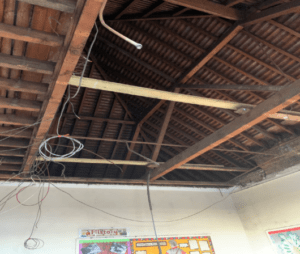SHP provides a summary and timeline of the events with RAAC, tracking the development of one of the biggest public building safety stories in UK history, Dani Wozencroft reports.
One of the largest public building safety risks has been developing across England.
 Almost 600 schools with a type of concrete prone to collapse have been told they may have to close or partly close immediately while improvements are made – such as ceilings being propped up. It means approximately 700,000 pupils are at risk from unsafe or ageing properties.
Almost 600 schools with a type of concrete prone to collapse have been told they may have to close or partly close immediately while improvements are made – such as ceilings being propped up. It means approximately 700,000 pupils are at risk from unsafe or ageing properties.
The reinforced autoclaved aerated concrete (RAAC) was widely used to build schools between 1950 and the mid-1990s.
But who knew what and when?
Take a look at the timeline of events below:
1950s: RAAC is used to build schools across England as it was cheaper and lighter than traditional concrete. It had an estimated lifespan of 30 years and this continued to be used in buildings until the mid 1990s.
1996: The Building Research Establishment (BRE) published a report which revealed excessive deflections and cracking had been identified in a number of RAAC roof planks. This effectively meant RAAC stopped being used.
1999: The Standing Committee on Structural Safety (SCOSS) published a report which urged those responsible for schools with RAAC-plank roofs built before 1980 to ‘arrange for these roofs to be inspected if this has not been done since 1994’. The report did add that generally SCOSS felt ‘the deterioration of RAAC planks does not jeopardise structural safety’.
2017: The government launched a three-year school inspection programme, part of which was to look at the materials such as RAAC.
July 2018: The roof of Singlewell Primary School in Gravesend, Kent, collapsed at a weekend because of RAAC failing.
December 2018: The Department for Education (DfE) and Local Government Association (LGA) told all owners of school buildings in England about the incident at Singlewell Primary School as well as general risks of failing RAAC. They advised building owners to check roofs, walls and floors made of RAAC ‘as a matter of urgency’ as they now recognised there could be failings without any visual signs of it.
May 2019: The Standing Committee on Structural Safety (SCOSS) issued an alert to all government departments and local authorities with responsibility for schools, hospitals, churches and public offices. They warned about the collapse at Singlewell Primary School and said ‘pre-1980 RAAC planks are now past their expected service life’. The SCOSS recommended they are all replaced.
2019: The government’s three-year inspection programme was completed and the DfE concluded that between 300 and 400 schools needed replacing each year.
The Ministry of Defence (MoD) issued an alert to UK estates staff regarding RAAC and highlighted a partial shop collapse.
April 2020: SCOSS published findings from surveys of buildings that revealed RAAC beams suffered from water ingress, cracking, spalling and surface corrosion.
February 2021: The DfE publishes a guide on how to identify RAAC and said they have been ‘made aware of further sudden collapses of RAAC panels in roofs that appeared to be in good condition’ since the Singlewell Primary School collapse in 2018. The DfE tells schools who find RAAC in their buildings to inform the department, which will then arrange an inspection.
October 2021: The government announces a pledge to rebuild 500 schools over the next decade as part of the Autumn Spending Review.
November 2021: A ceiling collapses at Rosemead Preparatory School in Dulwich, South East London – a teacher and 15 year three pupils were injured. The school trust was later fined by the HSE for failing to carry out any structural or load bearing capability assessments of the attic above, which was storing desks and chairs. You can see more on the legal ramifications of RAAC in SHP’s interview here with Andrew Sanderson, Partner and Head of the Health and Safety team at law firm Fieldfisher.
2022: The Building Research Establishment (BRE) published a research paper highlighting ‘excessive’ deflections and cracking in many older buildings using RAAC.
March 2022: The DfE issued a survey to those responsible for school buildings in an effort to discover the scale of RAAC in UK schools. Many did not respond.
March 2022: Public Accounts Committee reported on the risks to schools financial sustainability, including wide variations in the condition of individual schools and their funding.
September 2022: Surveyors went to schools to see if RAAC was present and rate how critical it was.
The Office of Government Property issued a warning that RAAC ‘is now life-expired and liable to collapse’.
October 2022: Councils were chased for responses to the DfE survey and were told it was ‘of the greatest importance’ and that buildings with RAAC must be monitored ‘to ensure they remain safe’.
December 2022: The DfE revealed school buildings are ‘very likely’ to risk collapsing due to RAAC and a public inquiry was set up.
February 2023: Seven education unions demand urgent action on the risk of school building collapses. Union bosses described the situation as ‘shocking’ and said it had ‘reached rock bottom’.
March 2023: The MoD told military officials to check for RAAC in buildings by the end of July, with fixes to be carried out by December.
Loughborough University, investigating RAAC for NHS England, said seven health trusts had buildings predominately constructed of RAAC.
June 2023: The National Audit Office (NAO) published the Condition of school buildings report which identified 572 schools which might have RAAC present. The report said 196 of them had received assessments from surveyors with confirmation at 65 schools, 24 of which require immediate action.
The report also revealed a safety risk from asbestos, identifying 13,800 system-built blocks containing asbestos, of which approximately 3,600 were potentially unstable.
It said insufficient funding was increasing the risk of these issues.
The DfE told four schools in Essex and the North East of England to close because of the RAAC found in ceilings – pupils were taught online or at other sites.
July 2023: Another collapse in a school building – previously not thought to have been at risk – is reported.
The HSE Annual General Meeting recognised issues around RAAC in hospitals and schools can give rise to serious breaches of Section 3 of the Health and Safety at Work Act – and that employers are not engaging with them on this appropriately.
HSE released a report which revealed of the 421 recent school inspections it carried out across England, Scotland and Wales, 7% had ‘significant failings’ in their asbestos management arrangements which required enforcement action to address them.
Further reading: Unsafe school buildings in England pose risk to pupils, report says
A government inquiry is held by the Public Accounts Committee. You can watch it here.
August 2023: Several schools identified as containing RAAC, but previously believed to be safe, then suffer structural failures.
The DfE then orders 104 schools and colleges with identified RAAC to close buildings or partially close buildings. This happens days before the start of the new school term.
The DfE issued new guidance for schools on what to do if they have RAAC, or suspect they have it, in their buildings and send out structural engineers to inspect hundreds more schools which had been built between the 1950s and the mid 1990s.
Education Unions send a letter to the government demanding answers on the crisis.
September 2023: The government announced 100 schools will be contacted before the new term begins – and will not be able to fully reopen until safety measures have been implemented. They confirm that it will take until December to inspect all 600 potentially affected schools and then many weeks after that to effect repairs.
The government published an official list of 147 schools they said are at risk due to crumbling concrete. The DfE said four of them were teaching all pupils online, 20 were providing a hybrid of face to face and online learning and a further 19 had delayed the start of the school year.
The schools listed were determined by responses to the government survey as of August 30 – 5% of schools had not responded – and those who had been inspected by a surveyor appointed by the DfE, not the buildings which had RAAC confirmed by their own surveyor.
The DfE said the number of schools on the list could change.
SHP will continue to follow developments in this story.
Why should you subscribe to the SHP newsletter?
Do you want the very latest health and safety news, product launches, job listings and expert opinions sent straight to your inbox daily?
The SHP newsletter is essential reading – sign up today to get your hands on all this!

 Almost 600 schools with a type of concrete prone to collapse have been told they may have to close or partly close immediately while improvements are made – such as ceilings being propped up. It means approximately 700,000 pupils are at risk from unsafe or ageing properties.
Almost 600 schools with a type of concrete prone to collapse have been told they may have to close or partly close immediately while improvements are made – such as ceilings being propped up. It means approximately 700,000 pupils are at risk from unsafe or ageing properties.
